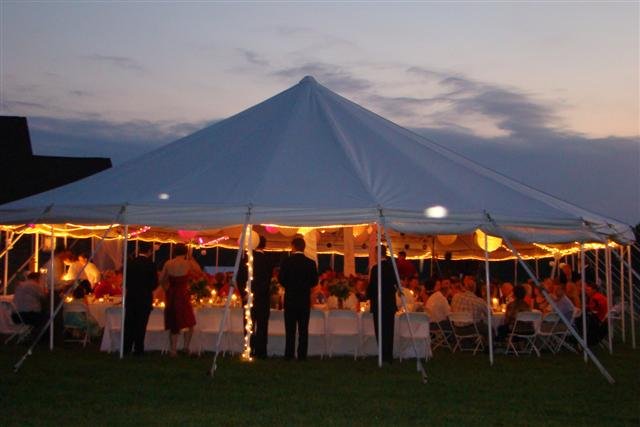The # 1 concern is Safety: Evacuate the Tent Site. The tent installer/ end user is liable for preparing for and keeping an eye on weather conditions. Failure to leave the party tent up during serious weather condition can lead to severe injuries or casualties.
Effects of Inclement Weather on a Tent

Rain: Rainwater can gather on the tent material and cause ‘ponding’ or ‘water pocketing’ under certain weather, specifically if the tent is not set up or tensioned properly. The extra weight from the water will certainly trigger the tent to sag and ponding will certainly remain to become worse. The weight can destroy the tent material and/or the poles, pole plates and baseplates to sink into the soil. In addition, extremely saturated soil will cause the stakes to lose their holding power. Losing tension from the stakes will cause poles to become unstable, thereby making the structure harmful.
Wind: Wind or wind with rain can cause the stress of the tent to change by loosening ratchet assemblies, pulling stakes, or causing the poles to move or sink. It is essential to do regular upkeep checks and maintain correct tension on the tent top at all times, particularly if weather are such that cogs are starting to loosen.
Lightning: Immediately evacuate the tent until the possibility of a lightning strike is not present.
Snow: Tents, canopies, structures, and shelters are not manufactured to withstand heavy snow loading. These products need to not be used if snow of any kind is present or anticipated, and guest should be evacuated immediately in case of snow load collapse.
Preparing a Tent for Severe Weather
In preparing for extreme weather, Miami Tent advises that the tent be taken down or the material be dropped to the ground to lower wind resistance. If the tent must stay up, there are a few things that can be done to prepare for winds and heavy rain.
Tension the Tent: If a tent needs to be left up in extreme weather, it is essential that the stakes are protected and the ratchet assemblies and tent top material are as tight as possible. Tension each staking point and include extra stakes and stake plates at corner locations, lace lines, and secondary poles. Be aware that significant rainfall can fill the soil and cause stakes to loosen and potentially fail when incorporated with heavy wind.
Remove the Sidewalls: When high wind is expected sidewalls can be removed from the tent to decrease wind load pressures on the tent. A tent without sidewalls will allow wind to travel through the tent and lower the possibilities of side poles being knocked out.
Add Anti-Sink Pole Plates: For pole tents, set all side poles and set center poles on anti-sink plates. Larger tents might require numerous pole plates stacked on one another at all center, corner and lace line pole places. Anti-sink plates will certainly increase the stability as wind forces are moved onto the poles; this reduces the results of the poles sinking into the soil, making impressions in asphalt, or moving on concrete.
Summary
We reiterate, safety is the #1 priority when planning your outdoor event. If inclement weather condition is expected while your event party tent is set up in location, make sure you follow these tent safety tips outlined in this article. By following and practicing these safety tips above, you’ll ensure your next social event is not only fun, but safe!
